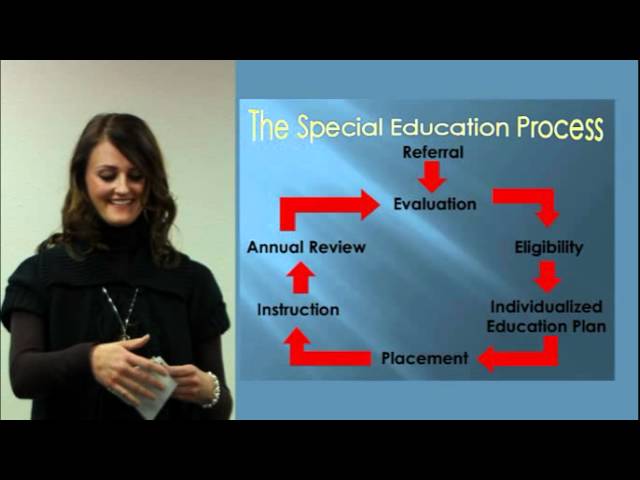The referral process for special education involves assessing a student’s needs, gathering relevant information, and initiating an evaluation to determine eligibility for services. This process aims to identify and address the unique learning needs of individuals with disabilities, providing them with appropriate support and interventions.
In special education, referrals are typically initiated by teachers, parents, or other professionals who have concerns about a student’s academic, social, or behavioral progress. Once the referral is made, a team of professionals collaborates to gather data, conduct assessments, and determine if the student qualifies for special education services.
This process enables individuals with disabilities to receive the necessary interventions and accommodations to promote their academic and overall development.
Understanding Special Education Referral
Understanding Special Education Referral
Special education referral is a crucial process for identifying students who may require special education services. Essentially, it involves the determination of whether a student has a disability and requires individualized educational support. The referral process is typically initiated by various individuals or organizations, including:
- Teachers
- Parents or guardians
- School administrators
- Healthcare professionals
- Others involved in the student’s education
The referral process is defined by its importance in ensuring that students with disabilities receive appropriate educational interventions. It involves assessing a student’s strengths and needs and gathering relevant information to make informed decisions regarding special education services. Ultimately, special education referral aims to provide students with the necessary support to succeed academically and reach their fullest potential.
Step 1: Initial Screening
Step 1: Initial Screening
Conducting academic and behavioral screenings
During the referral process for special education, it is essential to conduct thorough screenings to determine the needs of the students. These screenings involve analyzing both the academic and behavioral aspects of the student’s performance. Various assessment tools are utilized to gather valuable information about the student’s abilities and challenges.
Utilizing assessment tools to analyze student needs
Assessment tools, such as standardized tests, teacher observations, and behavior rating scales, provide valuable insights into the student’s strengths and weaknesses. Gathering objective data helps in identifying their specific needs and areas that require further attention.
Identifying students who require further evaluation
Based on the initial screenings and assessment results, students who show significant challenges or discrepancies in their academic and behavioral performance can be identified. These students then undergo further evaluation to determine their eligibility for special education services.
Step 2: Formal Evaluation And Assessment
Gathering comprehensive data on student’s academic, behavioral, and social-emotional abilities:
To ensure a thorough understanding of a student’s needs, the referral process for special education involves gathering comprehensive data on various aspects of their academic, behavioral, and social-emotional abilities. This may include conducting assessments, reviewing academic records, observing classroom behaviors, and seeking input from teachers and parents.
Collaborating with parents, teachers, and relevant professionals:
Collaboration is key to the referral process. It involves working closely with parents, teachers, and relevant professionals to gather valuable insights and perspectives on the student’s strengths and challenges. By incorporating different viewpoints and expertise, a more accurate assessment can be made, ensuring the student receives the appropriate support and interventions.
Administering assessments tailored to the student’s suspected disability:
During the referral process, specific assessments are administered to gather data related to the student’s suspected disability. These assessments are tailored to the individual needs of the student and may include cognitive assessments, behavioral assessments, speech and language assessments, or other specialized assessments as deemed necessary. The results of these assessments play a crucial role in determining eligibility for special education services and developing an appropriate Individualized Education Program (IEP) for the student.
Step 3: Multidisciplinary Team Meeting
The third step in the referral process for special education involves assembling a team of professionals to review evaluation results. This team typically consists of specialists such as psychologists, speech therapists, occupational therapists, and educators.
During the meeting, the team discusses the student’s strengths, weaknesses, and eligibility for special education services. They carefully analyze the evaluation results to gain a comprehensive understanding of the student’s needs.
If the team determines that the student is eligible for special education services, they proceed to formulate an Individualized Education Program (IEP). This program is tailored to meet the unique needs of the student and includes specific goals, accommodations, and support services.
The multidisciplinary team meeting is a crucial step in the referral process, as it ensures that the student’s educational needs are thoroughly evaluated and addressed. By working together, the team can provide the best possible support and resources for the student’s educational journey.
Step 4: Parental Consent And Iep Development
The referral process for special education involves several steps, and Step 4 is focused on obtaining parental consent and developing an Individualized Education Program (IEP) for the student.
During this step, the evaluation results and recommendations are explained to parents in a clear and accessible manner. It is essential to ensure that parents understand the findings of the evaluation and what they mean for their child’s education.
After explaining the evaluation results, the next important step is obtaining parental consent to proceed with special education services. Collaboration with parents is crucial during this process, as their input and participation are vital in developing a customized IEP for the student.
The IEP outlines the specific goals, services, and accommodations that will be provided to support the student’s learning and development. It is tailored to meet the unique needs of each student and serves as a roadmap for their educational journey in the special education program.

Credit: www.greatschools.org
Step 5: Implementation Of Special Education Services
Step 5 of the referral process for special education involves the implementation of special education services. This includes assigning appropriate services and accommodations based on the Individualized Education Program (IEP). Special education professionals carefully review the IEP to determine the specific services and accommodations needed for the student’s success. Regular progress monitoring is a crucial part of this step. Teachers and related service providers regularly gather data to assess the student’s progress towards their goals and objectives outlined in the IEP. This data helps identify areas of improvement and determine if any adjustments need to be made to the IEP. Effective communication between parents, teachers, and related service providers is essential throughout this process. Regular meetings and updates ensure that everyone is informed about the student’s progress and any necessary adjustments being made to the services and accommodations provided.
Step 6: Periodic Review And Reevaluation
htmlThe periodic review and reevaluation of special education services are crucial to ensure their effectiveness. It involves assessing the student’s progress and modifying the Individualized Education Program (IEP) accordingly. This process allows for adjustments to be made based on the changing needs of the student. During the periodic review, educators and specialists reevaluate the student’s eligibility for special education if necessary. They examine whether the current services and accommodations are still appropriate and make any necessary modifications to support the student’s continued growth and development. By regularly reviewing and reevaluating the special education services, educators can ensure that the student’s needs are met, and they can provide the best educational experience possible.
Step 7: Transitioning And Exiting Special Education
The referral process for special education involves several steps, including planning and facilitating a smooth transition for students who are transitioning from special education services to mainstream classrooms. This step, known as Step 7, focuses on ensuring the student’s continued success and support post-transition, as well as the process of exiting special education services when the student no longer requires intervention.
The goal of planning and facilitating a smooth transition is to ensure that students feel prepared and supported as they move from the specialized instruction of special education to the general education environment. This may involve collaboration between special education teachers, general education teachers, parents, and support staff, as well as the development of individualized transition plans.
Once a student has successfully transitioned and is thriving in mainstream classrooms, it may be determined that they no longer require special education services. The process of exiting special education services involves evaluating the student’s progress and determining if the supports and interventions are still necessary. If it is determined that the student no longer requires special education, a plan will be put in place to maintain their success and ensure ongoing support as needed.
Frequently Asked Questions On What Is The Referral Process For Special Education
What Are The Steps Of The Referral Process?
The referral process involves five steps. Firstly, a customer refers someone to a business. Secondly, the referral is received and acknowledged by the business. Thirdly, the referral is evaluated to determine its potential. Fourthly, the referred person is contacted to gauge their interest.
Finally, if they are interested, they become a customer of the business.
What Is The First Step In The Special Education Referral And Identification Process?
The first step in the special education referral and identification process is the referral of a student by a teacher or parent.
What Is The Referral Step Of The Iep Process?
The referral step of the IEP process is when a student is recommended for an evaluation to determine if they qualify for special education services. It involves making a formal request to the school and providing documentation of the student’s needs.
What Is Referral Process?
Referral process is a system where existing customers recommend new customers to a business. It helps companies acquire new clients through word-of-mouth marketing.
Conclusion
To summarize, understanding the referral process for special education is essential for both parents and educators. By following the necessary steps, such as initiating the referral, conducting evaluations, and implementing individualized education programs (IEPs), students with special needs can receive the support they require to thrive academically and emotionally.
Collaboration between all stakeholders ensures that every child’s unique needs are addressed effectively. With this knowledge, parents and educators can navigate the referral process with confidence and advocate for the best educational opportunities for children with special needs.







